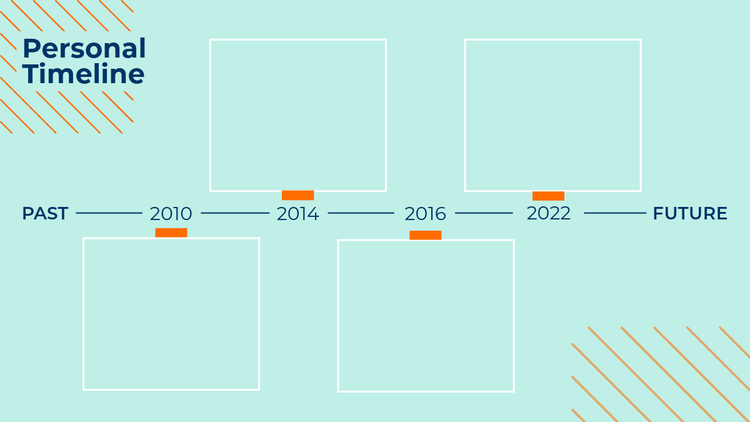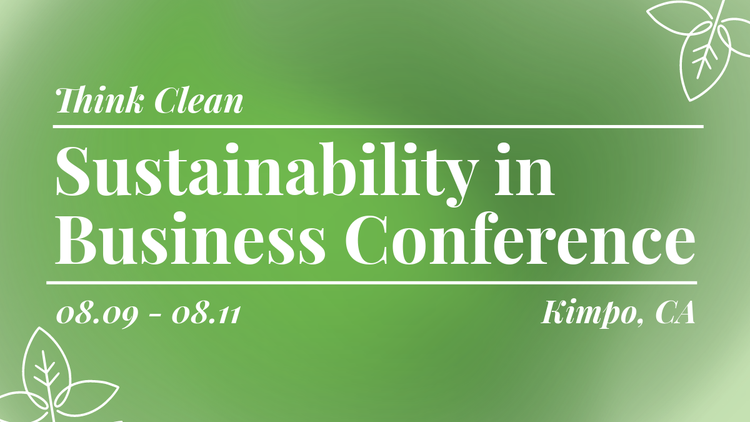If Winston Churchill had a laptop: “We Shall Fight on the Beaches” as a digital presentation
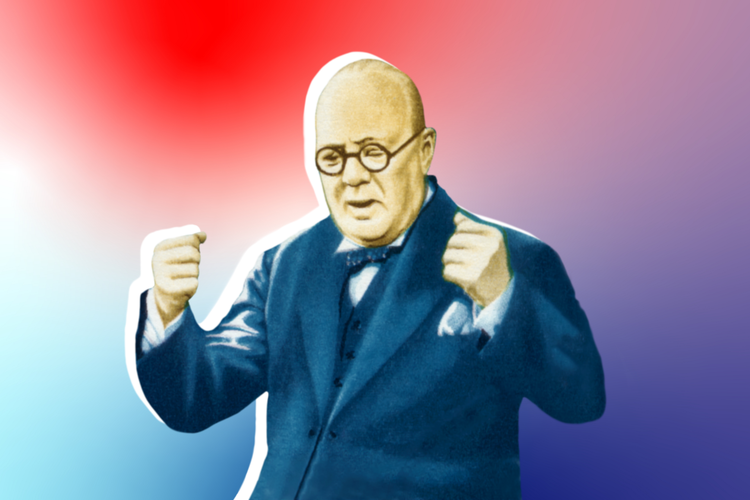
The stakes were high as Prime Minister Winston Churchill prepared his speech for the British House of Commons in early June of 1940.
France had just fallen to Nazi forces, and although British citizens were widely celebrating the miraculous rescue of 300,000 soldiers at Dunkirk, Britain’s shores were more vulnerable to enemy attacks than ever.
Churchill needed to write a speech that would contain the excitement over Dunkirk and convey the seriousness of Britain’s situation while also rallying enthusiasm and support for the ongoing war. It was a tall order — a speech that would simultaneously subdue and inspire the people of Britain and the world.
The resulting address, “We Shall Fight on the Beaches,” became one of the most famous speeches in history. Also known as Churchill’s Dunkirk speech or the Never Surrender speech, it’s studied worldwide today as a powerful example of motivational and persuasive speaking.
While there’s a lot to learn from how Churchill crafted his arguments and selected his words, public speaking today involves much more than just speaking — it requires a full audio-visual approach to presentation. Technological advances since Churchill’s time have made us wonder: what if he’d had a laptop?
If Churchill had access to the sophisticated tools that exist today, what kind of digital presentation would he have created to accompany his iconic speech? What presentation templates and images would he have chosen to evoke the emotions of Dunkirk? What charts and graphs could have conveyed the heavy toll of casualties? How would Churchill have used video and audio elements to bring to life the resolve of the British people?
As someone who put careful thought into crafting and polishing his speeches, it’s likely Churchill would have found potent ways to use today’s creative tools to give his speeches maximum impact.
In this article, we’ll use “We Shall Fight on the Beaches” to demonstrate how you can combine time-tested speech-writing tips with today’s technology to create persuasive presentations along with compelling, eye-catching slide decks.
The basics of persuasive speaking
The art of persuasive speech is as old as language itself. Aristotle taught that effective persuasion relies on the speaker’s use of three strategies to appeal to the audience:
1. Logos, or appeal to logic and reason
The speaker uses facts, statistics, and evidence to make clear, logical connections and convince audiences of the rationality of an idea.
Here’s an example of logos in a quote from Churchill’s speech:
“The Royal Air Force engaged the main strength of the German Air Force, and inflicted upon them losses of at least four to one; and the Navy, using nearly 1,000 ships of all kinds, carried over 335,000 men, French and British, out of the jaws of death… We must be very careful not to assign to this deliverance the attributes of a victory. Wars are not won by evacuations. But there was a victory inside this deliverance.”
2. Pathos or appeal to feeling
The speaker deliberately uses words and stories that evoke certain emotions, such as empathy, amusement, sadness, or anger, to make an audience feel a connection to the speaker’s ideas.
Here’s an example of pathos in a quote from Churchill’s speech:
“We shall not flag or fail. We shall go on to the end. We shall fight in France, we shall fight on the seas and oceans, we shall fight with growing confidence and growing strength in the air. We shall defend our Island, whatever the cost may be. We shall fight on the beaches, we shall fight on the landing grounds, we shall fight in the fields and in the streets, we shall fight in the hills; we shall never surrender.”
3. Ethos, or appeal to character
The speaker demonstrates personal authority and credibility through language, sources, credentials, personal experiences, and consideration of counterarguments.
Here’s an example of ethos in a quote from Churchill’s speech:
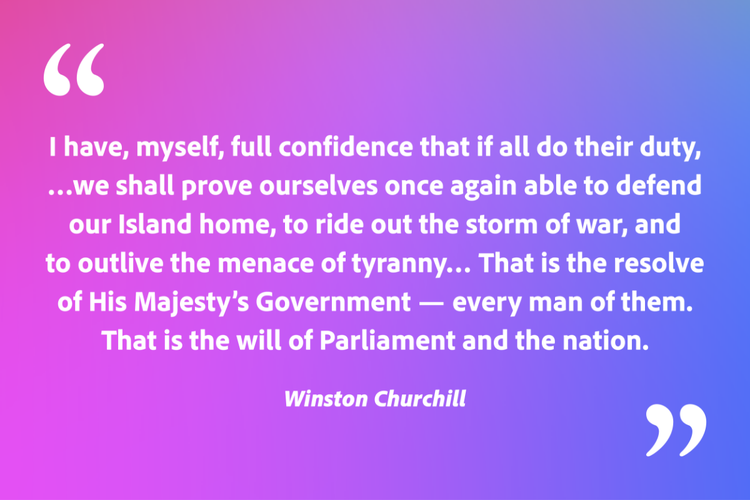
Five tips for creating a persuasive speech and presentation
Churchill was a lifelong student of public speaking, and he believed anyone could learn to be a powerful presenter. He identified five elements of speaking that can help you connect with and move your audience, whatever your topic.
Get started by choosing a presentation template that reflects the appropriate tone and subject matter of your speech. Then, use these five tips — based on Churchill’s five elements — to craft your speech and bring it to life.
1. Choose simple, powerful words
Churchill believed that flowery language distracted from a speaker’s ability to persuade an audience. Instead, he favored short, precise words that were clear and easy to understand. Churchill advised speakers to take the time to carefully select the “best possible words” and then deliver them with power.
Presentation tip: Text formatting can amplify or detract from your carefully chosen words. Be just as intentional about how they’re visually rendered.
2. Paint a picture
Churchill was fond of using analogies to make ideas feel more visual and concrete — as well as emotional. For example, he coined the phrase “Iron Curtain” to describe the political and ideological barrier between the Soviet Union and the West. Visual descriptions and analogies have the power to bring arguments to life, making them more immediate and real to listeners.
Presentation tip: In addition to painting pictures with words, add images to your presentation to help the audience visualize and connect with your topic. For example, if slide decks had been around in Churchill’s day, he might have shown photos of soldiers at Dunkirk as he described the heroic rescue.
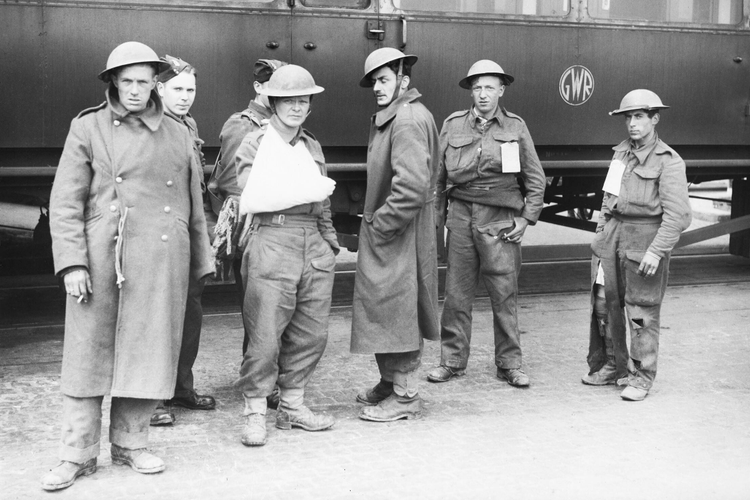
If you have a large number of compelling photos, consider using a slideshow template to display them before, during, or after your presentation.
3. Build your argument one step at a time
Churchill called this strategy “accumulation of argument,” or using a series of facts (i.e. logos) to point a speech in a common direction and build to a crescendo. The audience should be able to follow and anticipate where the speech is going, which builds enthusiasm as they become eager for the final conclusion and ready to applaud thunderously when it arrives.
Presentation tip: Help your audience follow your arguments by displaying factual information in charts and graphs. Churchill’s speech included hard numbers about the number of soldiers rescued at Dunkirk that could have been visualized as charts.

4. Use rhythm and repetition
Churchill believed sound had the most impact on the human brain when sentences were “long, rolling, and sonorous.” He often used repetition or pauses to create a mood and emphasize important points. Listening to great speeches and reading your speech out loud can help you understand how to use rhythm and tempo to make your presentations flow.
Presentation tip: In addition to using the cadence of your own words, embed other voices into your presentation and play them for your audience. This example includes audio of soldiers in 1940 describing their experiences at Dunkirk firsthand.
5. Create emotional impact
Churchill’s final strategy was something he called “wild extravagance,” or appealing to an audience’s emotions (i.e. pathos) by powerfully expressing something they already feel. He often described an obviously extreme case with over-the-top imagery to magnify emotional impact, knowing that effective persuasion requires winning both hearts and minds.
Presentation tip: Studies show that video is one of the most powerful media available because it stimulates multiple senses and creates a strong emotional impact. Create a multimedia presentation by adding video that drives home your message, such as this 1940 video of Dunkirk.
Presentation animations can also add movement that emphasizes particular points in your talk track and creates a dynamic experience for your audience.
With all these options for building captivating presentations, it’s not hard to imagine how creative Churchill might have been with his famous Dunkirk speech. Combining his tips for persuasive speaking with modern digital capabilities, you’ll be ready to make a powerful impact with your next presentation.
Design powerful presentations with Adobe Express
Whatever your topic, Adobe Express has all the creative tools you need to craft a powerful, persuasive speech with engaging presentation templates for any topic.
Create a presentation using Adobe Express.
